In the last decade I’ve started a tradition of traveling abroad over Thanksgiving. It’s not that I don’t like the most American of holidays, with the overeating and binge shopping, it’s just a good time to take advantage of decent international flight prices and a long weekend.
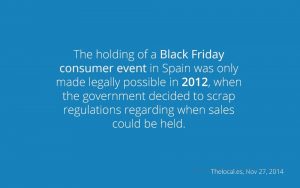 This year I visited some friends in Spain and when I arrived in Madrid Thanksgiving morning, I was immediately stunned by posters advertising Black Friday deals everywhere. I asked my hosts what this was all about. One of my friends works for Ikea Spain and explained that Black Friday, written in English not Spanish, was a big deal in Spain and Europe now. I was surprised and wondered how this happened. In the US it’s a day a lot of Americans don’t work and also marks a sort of kick-off to holiday shopping. How did this get to be so popular abroad and when?
This year I visited some friends in Spain and when I arrived in Madrid Thanksgiving morning, I was immediately stunned by posters advertising Black Friday deals everywhere. I asked my hosts what this was all about. One of my friends works for Ikea Spain and explained that Black Friday, written in English not Spanish, was a big deal in Spain and Europe now. I was surprised and wondered how this happened. In the US it’s a day a lot of Americans don’t work and also marks a sort of kick-off to holiday shopping. How did this get to be so popular abroad and when?
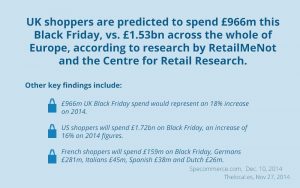 My friend at Ikea Spain spent all Friday, from early morning till late at night, managing staff at one of Madrid’s main stores which received a record number of customers that day. Some had even lined up the night before for Black Friday deals. From the sounds of the chaos, it sounded pretty all American. Out of curiosity I read up on it further and learned that in the last two years “Black Friday” or “Black Weekend,” as it’s called in Germany, is popular now in a number of countries.
My friend at Ikea Spain spent all Friday, from early morning till late at night, managing staff at one of Madrid’s main stores which received a record number of customers that day. Some had even lined up the night before for Black Friday deals. From the sounds of the chaos, it sounded pretty all American. Out of curiosity I read up on it further and learned that in the last two years “Black Friday” or “Black Weekend,” as it’s called in Germany, is popular now in a number of countries.
How did this happen?
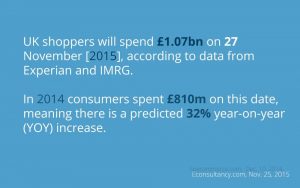 A couple of factors contributed to the globalization of this shopping event. First, global brands seeking greater profits from their stores abroad exported the idea. The UK can thank Amazon and Asda (a subsidiary of Wal-Mart) for being the first to introduce Black Friday across the pond.
A couple of factors contributed to the globalization of this shopping event. First, global brands seeking greater profits from their stores abroad exported the idea. The UK can thank Amazon and Asda (a subsidiary of Wal-Mart) for being the first to introduce Black Friday across the pond.
Apple had its hand in making this a global affair, as did a number of other global US brands.
It took a few years, and after some initial distaste for this most American of traditions, by 2014 many British brands came on board with their own Black Friday specials. At this point it was only a matter of time for the idea to spread across Europe. Similarly, the trend is starting to slowly spread across Asia, with traction seen in India in recent years.
Another reason Black Friday went global was the simple economics of demand. International consumers were already taking advantage of deals online and companies responded with adding additional incentives such as free or cheap international shipping. Retailers and brands who were purely local, such as Tesco in the UK, created deals to compete with these companies.They also saw from the data that it’s just good for business.
So how should you plan your Black Friday strategies now?
Retailers need to jump on board and start globalizing their Black Friday thinking now.
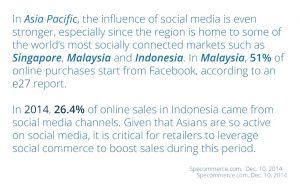 As we know from the US, the more this concept catches hold, the more intense the competition will become. Companies need to develop international strategies around this day early in order to capture consumers while the momentum is growing. Whether you have stores abroad or just online reach to those markets, well planned digital marketing campaigns will keep you on top of nurturing those customers.
As we know from the US, the more this concept catches hold, the more intense the competition will become. Companies need to develop international strategies around this day early in order to capture consumers while the momentum is growing. Whether you have stores abroad or just online reach to those markets, well planned digital marketing campaigns will keep you on top of nurturing those customers.
Think about localizing your content and your deals. This means not only translating your campaigns, but localizing the offers, and understanding what will competitively work in that market. Marketing automation software, such as VBOUT’s helps segments your visitors by location and allows you to tailor content accordingly.
Start thinking about developing social media pages just for those markets, and again, you can use marketing automation to manage all these pages from one easy platform. Going global has become easier with these tools available to marketers.
With marketing automation you can also schedule social media posts in advance so that they appear at peak viewing times in different countries, which may be while you’re sleeping.
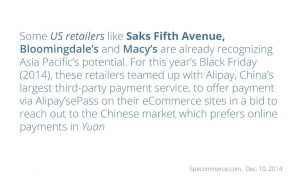 It may seem like next year’s Black Friday is far enough away, but successfully tailoring your campaigns for a new market takes a lot of planning and preparation. As we’ve also seen in the US, as competition intensifies, retailers often start launching Black Friday notices and campaigns earlier and earlier in the year, sometimes even in October.
It may seem like next year’s Black Friday is far enough away, but successfully tailoring your campaigns for a new market takes a lot of planning and preparation. As we’ve also seen in the US, as competition intensifies, retailers often start launching Black Friday notices and campaigns earlier and earlier in the year, sometimes even in October.
Don’t forget to share this article


